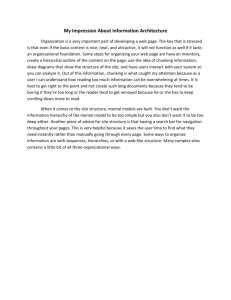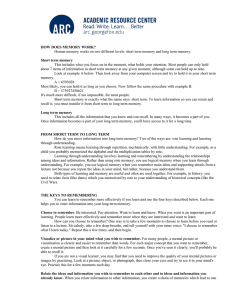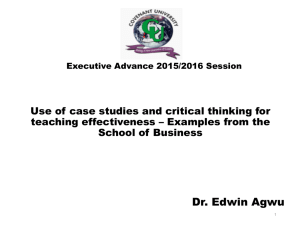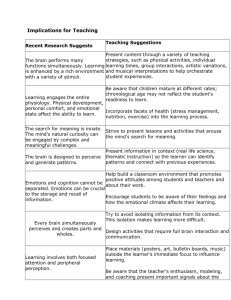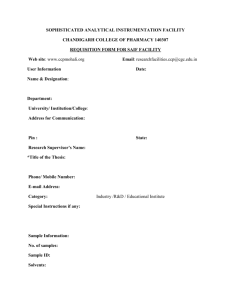www.ijecs.in International Journal Of Engineering And Computer Science ISSN:2319-7242
advertisement
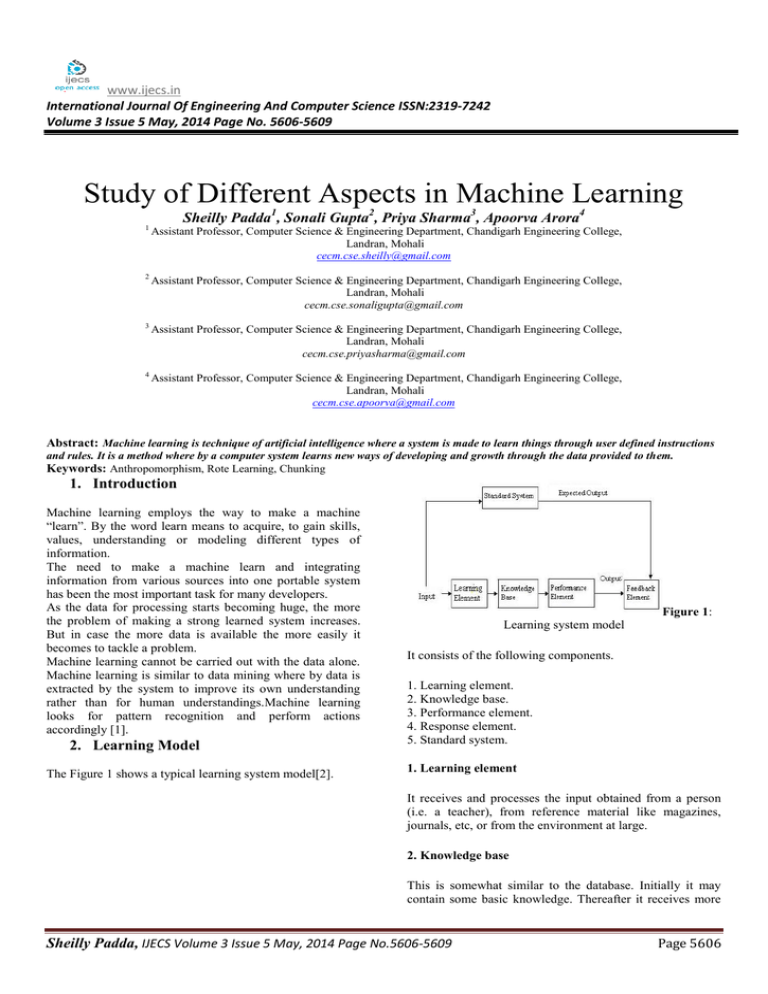
www.ijecs.in International Journal Of Engineering And Computer Science ISSN:2319-7242 Volume 3 Issue 5 May, 2014 Page No. 5606-5609 Study of Different Aspects in Machine Learning Sheilly Padda1, Sonali Gupta2, Priya Sharma3, Apoorva Arora4 1 Assistant Professor, Computer Science & Engineering Department, Chandigarh Engineering College, Landran, Mohali cecm.cse.sheilly@gmail.com 2 Assistant Professor, Computer Science & Engineering Department, Chandigarh Engineering College, Landran, Mohali cecm.cse.sonaligupta@gmail.com 3 Assistant Professor, Computer Science & Engineering Department, Chandigarh Engineering College, Landran, Mohali cecm.cse.priyasharma@gmail.com 4 Assistant Professor, Computer Science & Engineering Department, Chandigarh Engineering College, Landran, Mohali cecm.cse.apoorva@gmail.com Abstract: Machine learning is technique of artificial intelligence where a system is made to learn things through user defined instructions and rules. It is a method where by a computer system learns new ways of developing and growth through the data provided to them. Keywords: Anthropomorphism, Rote Learning, Chunking 1. Introduction Machine learning employs the way to make a machine “learn”. By the word learn means to acquire, to gain skills, values, understanding or modeling different types of information. The need to make a machine learn and integrating information from various sources into one portable system has been the most important task for many developers. As the data for processing starts becoming huge, the more the problem of making a strong learned system increases. But in case the more data is available the more easily it becomes to tackle a problem. Machine learning cannot be carried out with the data alone. Machine learning is similar to data mining where by data is extracted by the system to improve its own understanding rather than for human understandings.Machine learning looks for pattern recognition and perform actions accordingly [1]. 2. Learning Model The Figure 1 shows a typical learning system model[2]. Figure 1: Learning system model It consists of the following components. 1. Learning element. 2. Knowledge base. 3. Performance element. 4. Response element. 5. Standard system. 1. Learning element It receives and processes the input obtained from a person (i.e. a teacher), from reference material like magazines, journals, etc, or from the environment at large. 2. Knowledge base This is somewhat similar to the database. Initially it may contain some basic knowledge. Thereafter it receives more Sheilly Padda, IJECS Volume 3 Issue 5 May, 2014 Page No.5606-5609 Page 5606 knowledge which may be new and so be added as it is or it may replace the existing knowledge. 3. Performance element It uses the updated knowledge base to perform some tasks or solves some problems and produces the corresponding output. 4. Response element It is receiving the two inputs, one from learning element and one from standard (or idealized) system. This is to identify the differences between the two inputs. The feedback is used to determine what should be done in order to produce the correct output. 5. Standard system It is a trained person or a computer program that is able to produce the correct output. In order to check whether the machine learning system has learned well, the same input is given to the standard system. The outputs of standard system and that of performance element are given as inputs to the feedback element for the comparison. Standard system is also called idealized system. of manual assistance [3]. Machine to machine learning is used in various fields of robotics, data warehouse management, traffic control, remote control and telemedicine. 4. Anthropomorphism Anthropomorphism is the technique where a system or an inanimate object is assumed to behave like humans without making any error [4]. In such cases these virtual characters interact with humans, able to communicate, express emotions and exhibit personality. Anthropomorphism can be used to create an autonomous human like character that can be referred to as artificial agents [5]. The main steps followed for creating a anthropomorphic character are hand designed animations, motion capture, automatic online motion generation, data driven methods, motion planning. To model a virtual human we have to consider three types of modeling: appearance of model should be like real human, smooth and flexible actions performance, and a realistic high level behavior which is the difficult challenge in the field of AI and robotics technology [6]. To create virtual humans with individuality there are two approaches: In first method we try to record the motion using different motion capture system which may be magnetic or optical as shown in the Figure 2. The sequence of operations described above may be repeated until the system gets the desired perfection. There are several factors affecting the performance. They are, Types of training provided. The form and extent of any initial background knowledge. The type of feedback provided. The learning algorithms used. Training is the process of making the system able to learn. It may consist of randomly selected examples that include a variety of facts and details including irrelevant data. The learning techniques can be characterized as a search through a space of possible hypotheses or solutions. Background knowledge can be used to make learning more efficient by reducing the search space. The feedback may be a simple yes or no type of evaluation or it may contain useful information describing why a particular action was good or bad. If the feedback is always reliable and carries useful information, the learning process will be faster and the resultant knowledge will be correct. The success of machine learning system also depends on the algorithms. These algorithms control the search to find and build the knowledge structures. The algorithms should extract useful information from training examples. There are several machine learning techniques available. I have explored some of the important techniques. 3. Machine to Machine learning Figure 2: Motion capture session The second method involves creating computational models based on parameters such as walking or motion of grasping objects and example is illustrated in Figure 3. Figure 3: Walking postures with two different skeleton sizes. 5. Rote Learning M2M enables different devices to process, exchange information and perform necessary actions without the need Sheilly Padda, IJECS Volume 3 Issue 5 May, 2014 Page No.5606-5609 Page 5607 Rote memorization is learning through repetitions. Rote learning is the easiest and most efficient way to inspire knowledge by memorization so that it forms a solid foundation on which to build an rational superstructure [7]. Rote learning is learning based on memorization and recurrence and includes the ability to remember a long amount of items for a period of time. Rote learning also lack creativity and the tendency to disregard the items memorized. The Figure 4 shows how rote learning is carried out in different steps. It is carried in the way where firstly the knowledge is created, through different sources, remembering whatever is created and then understand how to apply it in different situations.Lastly; the output of actions performed after gaining knowledge is analyzed and evaluated to see if it was successfully understood by a person. Chunking facilitates intellectual capacity and retrieval of information, group information into convenient units. For example, phone numbers are not typically seen or remembered as a long string of numbers like 8605554589, but rather 860-555-4589. Birthdates are typically not recalled by 11261995, but rather 11/26/1995. The breaking down of the numbers into chunks makes the number easier to remember. 7. Conclusion In this paper, we have discussed what machine learning is and what are the different ways of learning. We have also stated the learning model which is mostly used for creating an effective system which performs tasks as desired by the user. Machine learning is not an easy task as collecting data and making a system to make it learn requires a lot of effort on the part of developer as well as programmer. References Figure 4: Rote learning overview The vocabulary also plays a very important role in rote learning. Chinese learners’ belief the need of rote learning in vocabulary learning strategies [8]. Chinese believe that Rote Learning is an assimilation of repetition, memorization, perform, including review and understanding which suggests stability with traditional Chinese ethnicity and principles. 6. Chunking Chunking is defined as a way for making more competent use of short-range memory by grouping information. Chunking breaks up long strings of information into units or chunks. The resulting chunks are easier to commit to memory than a longer incessant string of information. Chunking is way of learning through sequence of actions that can be treated as a whole. Generally it is carried out by use of productions system that consists of rules, knowledge base and control strategy. In a production system the problem is solved when a system compares the present situation with the rules. If there is a match then the system will perform the actions described in the corresponding rule. Chunking can be used to learn general search control knowledge. Chunks learned in the beginning of problem solving, may be used in the later stage. The system keeps the chunk to use it in solving other problems [9]. Chunking is a strategy used to reduce the cognitive load as the learner processes information. The learner groups content into small manageable units making the information easier to process. Essentially, chunking helps in the learning process by breaking long strings of information into bit size chunks that are easier to remember [10]. [1] Margaret Rouse, Machine learning, January 2011. [2] Robin, Machine learning Overview, March 1st, 2010. [3] Margaret Rouse, Machine to Machine Learning, June 2010. [4] Margaret Rouse, Anthropomorphism, September 2005. [5] Sebastien Dalibard, Nadia Magnenat-Thalmann, and Daniel Thalmann, “Anthropomorphism of artificial agents: a comparative survey of expressive design and motion of virtual characters and social robots”, 25th Annual Conference on Computer Animation and Social Agents (CASA 2012), Singapore: Singapore (2012). [6] Nadia Magnenat-Thalmann Daniel Thalmann, “Virtual humans: thirty years of research,what next?”,Published online: 24 November 2005, Springer-Verlag 2005. [7] Sam Blumenfeld, “The Importance of rote Learning, Printed in Practical Homeschooling #34, 2000. [8] Xiuping Li, “An Analysis Of Chinese Efl Learners’ Beliefs about The Role Of Rote Learning in Vocabulary Learning Strategies”, April 2004. [9] Robin, “Article on Artificial Intelligence, November 26th,2009. [10] The Peak Performance Center - Copyright 2010 – 2013 [11] Sheilly Padda, IJECS Volume 3 Issue 5 May, 2014 Page No.5606-5609 Page 5608 Author Profile Sheilly Padda did her M.Tech and B.Tech from Punjab Technical University in 2012 and 2010.She has two years of teaching experience in the field of Computer Science and currently working as Assistant Professor at Chandigarh Engineering College,Landran,Mohali. Sonali Gupta received her M.Tech and B.Tech in Information Technology in year 2012.She has specialization in the field of databases.Currently, she is working as Assistant Professor in CSE department at Chandigarh Engineering College, Landran, Mohali. Priya Sharma has done her B.Tech in Computer Science and Engineering from PTU in year 2012 and pursuing M.Tech from PTU.She has two years of teaching experience and currently working as Assistant Professor at Chandigarh Engineering College, Landran, Mohali. Apoorva Arora has done her B.Tech in CSE from Kurukshetra University, Kurukshetra in year 2009 and M.Tech from JIIT Noida in 2012.She has more than two years of experience in teaching and currently working as Assistant Professor at Chandigarh Engineering College, Landran, Mohali. Sheilly Padda, IJECS Volume 3 Issue 5 May, 2014 Page No.5606-5609 Page 5609
